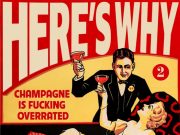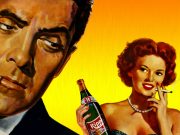Ian Stewart is not the type of guy who drinks to forget.
But for this British software designer, it only took one night, three shots, and an unasked question to alter the course of his life. Stewart came to Prague to ask his Czech girlfriend’s father for her hand in marriage. The father doesn’t speak English, so a mutual English-speaking Czech friend, Marek, accompanied them to a pub. Before Stewart popped the question, Marek ordered a round of “crème de menthes.” The first shot burned all the way down to Stewart’s stomach. So did the second and the third. An hour later, they were carrying Stewart home. He woke up early the next morning unable to move his legs. Having not asked the question, he got on the next plane back to England, where he would get medical attention. A month later, Stewart and his Czech girlfriend split up. Today, she’s married to someone else and Stewart is still wondering what the hell happened.
What Stewart didn’t know is that he was not drinking crème de menthe like Marek and the father of the potential bride-to-be. Thanks to Marek’s “funny” joke, Stewart was drinking Absinthe.
There’s a reason why, until recently, Absinthe was illegal in every country except for Spain, Portugal and the Czech Republic: if its main ingredient, wormwood, doesn’t temporarily paralyze—such as in Stewart’s case—it may cause hallucinations, madness, a tendency in late-19th century painters to chop off an ear or two, and a proclivity for Americans living in Prague to fancy themselves as writers.
So armed with my laptop, beret, roll-up cigarettes, and a copy of Kafka’s The Trial, I set out to be the next American expat to sample the crippling green elixir. The waitress actually rolled her eyes when she heard me utter the word. A few minutes later, she plopped a glass of Absinthe in front of me along with two packets of sugar, a spoon, and a lighter. Like heroin, this potent liquid has to be cooked before consuming. After filling up your spoon with sugar and dipping it in the drink, light a flame and hold it to the spoon. The point of this is not only to get everyone in the café to look at you because you’re holding a flaming spoon dangerously close to your face, but to caramelize the sugar. When the sugar starts to boil, blow it out and mix it in.
Absinthe’s history in the Czech lands dates back to 1917 when the distillery Hills Liqueurs began producing it. By World War II, it was considered such a staple that every Czech adult got a monthly half-liter ration. But after the 1948 communist coup, in which the country would be ruled from Moscow until 1989, Absinthe was banned, the party line claiming that it was “too bourgeois.”
The late-’80s/early-’90s were different. The Russians got booted and bourgeois was suddenly back. Hill’s Liqueurs dusted off its Absinthe-producing vats, making only one apparently small adjustment to its recipe: the new Absinthe now only contains 75% alcohol, while the old stuff had 80%, and that five percent, according to the company, is the crucial threshold in which the concentration of its paralyzingly strong ingredient, wormwood, becomes harmful.
I think the jury is still out on that one. After taking my first sip of this hemlock, which went down like rancid mouthwash, I stared at the glass of transparent green ooze in front of me, wondering: if I get through this, will my legs fall off? Will I feel the need to write bad poetry or wear all black? Or will I be transformed into a superhero who, after getting really angry and drinking a fluorescent green beverage, I’ll be able to tear off my shirt and throw heavy machinery. I slowly brought the glass to my lips again, paused, and then finished it off. My stomach felt like a three-alarm fire. Unfortunately, I was still wearing my shirt.
I decided to shift gears. The Czechs drink more beer per capita than anywhere in the world (about 340 liters a year per adult), but when they want something “healthy”—without compromising their drinking habit—they turn to one drink: Becherovka.
Becherovka is a mystery. No, really, it is. The recipe is a secret and is only known by two people. The only ingredient we do know is water—water from Karlovy Vary (or in German, Carlsbad), a spa town in northern Bohemia. For centuries, Europe’s aristocrats and better-known intellectuals have paraded their diseases through Karlovy Vary hoping that “taking the waters,” which are supposed to have medicinal benefits, will make them healthy again.
Enter Josef Becher. In 1807, this pharmacist, who had a passion for mixing herbs, aromatic oils, and alcohol (don’t we all?), came upon the recipe for his now famous elixir. A few years later he closed his pharmacy and went into the medicinal alcohol business, calling his drink Carlsbad English Bitter.
Like going to church and electing Texas politicians to higher office, no one’s really sure if it works. But we still keep trying. In fact, most Czechs view Becherovka as a cure for everything. Got a headache? Try Becherovka. Jaundice? Becherovka. Constipation? That’s right: Becherovka. Czech Pharmacies always have a few bottles behind the counter, as doctors regularly prescribe it for stomach ailments. Forget eating apples and popping pills, just drink.
And that’s just what I did. Becherovka has a bitter taste that may be a turn off to the taste buds at first. But after a sip or two, the appetite for this gingery liqueur can become insatiable. My parents hated the stuff when I brought it home from Prague for a visit a few years ago. But after finishing off the bottle, my father regularly pleads with me to send him “a bottle or three.”
A few glasses of Becherovka later, the fiery pit of hell that the Absinthe turned my stomach into was now doused. Placebo or panacea, I’m a believer. It’s too bad that Ian Stewart, the temporarily crippled software designer, didn’t know about Becherovka. He might be a married man.










